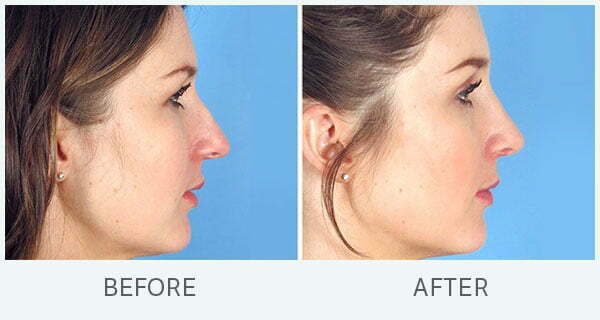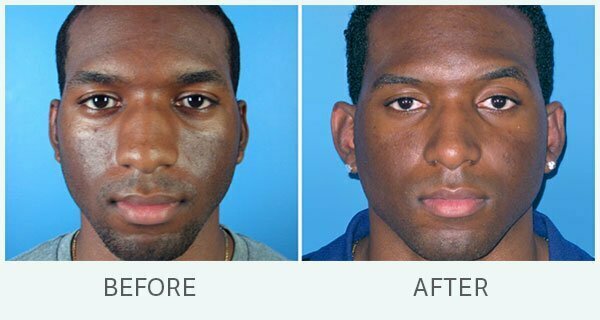7 Questions You Have About Nose Jobs, Answered

Thinking about changing the shape of your nose? If so, you’re in good company—more than 145,000 Americans had rhinoplasty surgery (a.k.a. a “nose job”) in 2015. If you feel like your nose doesn’t quite fit your face, rhinoplasty can help you refine your nasal profile and improve your overall appearance.
Our board certified plastic surgeons at the Swan Center have years of experience performing rhinoplasty in Atlanta. Below, we’ve shared answers to our patients’ most burning questions about nose surgery.
Choose a surgeon who is highly experienced in the specific rhinoplasty techniques you need to achieve your goal. A successful outcome with nose reshaping requires immense surgical skill.
1. What can a rhinoplasty fix?
Most patients seek rhinoplasty for cosmetic reasons, and there’s a lot we can do to improve nasal shape:
- Reduce the length, width, or overall size of the nose
- Straighten a bump or crooked nose
- Improve symmetry
- Reduce and refine a bulbous tip
- Reduce nostril size
- Correct a bad nose job
Rhinoplasty can also have functional benefits, improving breathing problems or repairing damage from injury. Smaller nasal septal perforations (holes in the nose), resulting from drug use or due to a complication from a previous surgery, can usually be closed surgically as well.
No matter what: choose a surgeon who is experienced in the specific rhinoplasty techniques you need to achieve your goal. Rhinoplasty is a highly specialized procedure, and a successful outcome requires immense skill.

2. How much does a nose job cost?
Like any cosmetic procedure, the price of rhinoplasty varies from patient to patient, depending on a number of factors:
- What you are having done (i.e., reducing size, repairing trauma, realigning the septum)
- Your individual goals and anatomy
- Your geographic location
- Surgeon experience
With our board certified plastic surgeons in Atlanta, rhinoplasty procedures typically range from $5,000 to $7,500, all-inclusive. It’s important to understand that these estimates reflect the average patient—a more involved surgery, such as a secondary rhinoplasty or a nose job combined with another procedure, will cost more. Comparatively simple procedures, such as reducing nostril size only, typically cost less.
Never choose a plastic surgeon based on cost alone. Nose reshaping is a complex cosmetic surgery and requires special skill and experience to produce beautiful results with minimal risk of complications. When you consult with potential surgeons, make sure you know what the fee quote you’re given includes, and that it is all-inclusive. Some practices only advertise surgeon’s fees, but you will also be responsible for operating room costs, anesthesia, and more.
3. How old do I need to be to get a nose job?
Rhinoplasty is a popular cosmetic surgery for younger patients: in 2015, 10,000+ procedures were performed on patients 18 and under. Since results are intended to be permanent, having the surgery as a teen or young adult can be a worthwhile investment in your appearance and well-being.
For a safe and successful surgery, it’s essential that the nasal bones and cartilage are fully developed—typically by age 16 for girls and 18 for boys.
Emotional maturity is also crucial. You need to understand the risks of surgery and be responsible enough to follow through with recovery and aftercare as instructed. You also need to realize that while rhinoplasty can help you feel more confident, it will not make your nose (or your life) “perfect,” or change another person’s opinion of you. Remember: you can always have surgery later, but you can’t easily “undo” the results of surgery once it’s done.
4. Is it possible that my nose is getting bigger with age?
Actually, it’s fairly common for the nose to change shape with age. Cartilage can become less supportive, causing the nasal tip to droop, making the nose appear longer or resulting in a “hooked” tip shape. Nasal skin can also thicken, causing the nose to appear larger or wider.
Rhinoplasty can fix either issue by building up cartilage, reducing the tip size, or making other adjustments to restore a better proportioned, more attractive nose. And, while you can be too young for rhinoplasty, there is no upper age limit, provided you are healthy. So if you are bothered by the size or shape or your nose as you age, go ahead and consult with an experienced, board certified plastic surgeon.
5. How much recovery time will I need after rhinoplasty?
While your new nose will continue healing for months after surgery, patients rarely need more than a couple of weeks of true downtime. The first week is the toughest. Pain is minimal, but your nose will be bandaged and placed in a splint, which can be uncomfortable. You will need to stick to very light activity at first and sleep on your back, with your head propped up.
You can go out in public after a nose job as soon as you feel comfortable doing so; however, most patients wait until obvious bruising and swelling have faded—typically after 10 to 14 days.
Plan on taking at least 7 days off of work for a desk job and 14 days or more for physical work. Bruising and swelling can be significant for the first 2 weeks. While you are welcome to go out in public as soon as you feel comfortable, most patients prefer to lay low until these obvious signs of surgery have faded—typically about 10 to 14 days into their rhinoplasty recovery.
If your nose seems swollen or slightly asymmetrical for weeks after surgery, don’t panic! Rhinoplasty results can about 3 months to get to a “nearly final” shape, and will continue to improve subtly for up to 1 year.

6. When can I exercise after nose surgery?
Generally, any activity more strenuous than walking is off limits for a minimum of 3 weeks after rhinoplasty. This includes (but is not limited to) running, dancing, cycling, strength training, and sex. Exercise raises blood pressure, increasing risk of internal bleeding and poor healing. After about three weeks, incision sites and reshaped tissues usually will have healed enough to withstand a temporary blood pressure increase. However, contact sports or activities that involve flying objects (basketball, tennis, etc.) should be avoided for 6 weeks or longer. Always follow your plastic surgeon’s instructions and only resume an activity after you get his or her thumbs up.
7. Are there non-surgical alternatives to rhinoplasty?
The short answer is that yes, alternatives do exist, but they are very limited in what they can achieve. Most providers offering a “non-surgical nose job” use dermal fillers to adjust the shape of the nose. Because fillers can only add volume to the nose, they are only useful in certain cases: to straighten a “ski slope” nose, camouflage a small bump, or improve mild asymmetry. Note that the results will only last about 1 year, after which you can repeat treatment.
While a non-surgical nose job may in some cases be a good way to “try on” a new nasal shape, a surgical rhinoplasty is the only way to ensure lasting results, or make any subtractive changes, which the majority of people want as part of their nose reshaping plan. Many plastic surgeons (including ours at the Swan Center!) offer computer imaging to help you envision your new nose before you commit to surgery.
Ask more questions, get more answers!
We hope this info has been helpful for you! If you have more questions about rhinoplasty, though, we’d love to hear them. Feel free to leave comment below, or better yet, ask your questions in person during a personal consultation with one of our board certified plastic surgeons! Our consults are informative, friendly, and free. Call us today to get started. We look forward to helping you!
1 Comment Posted to "7 Questions You Have About Nose Jobs, Answered"
Swan Center, thanks for answering my questions about nose job :). I was looking for like 10 mins to find recovery time duration. Anyway, I found my nose job surgeon in Naperville, Illinois.